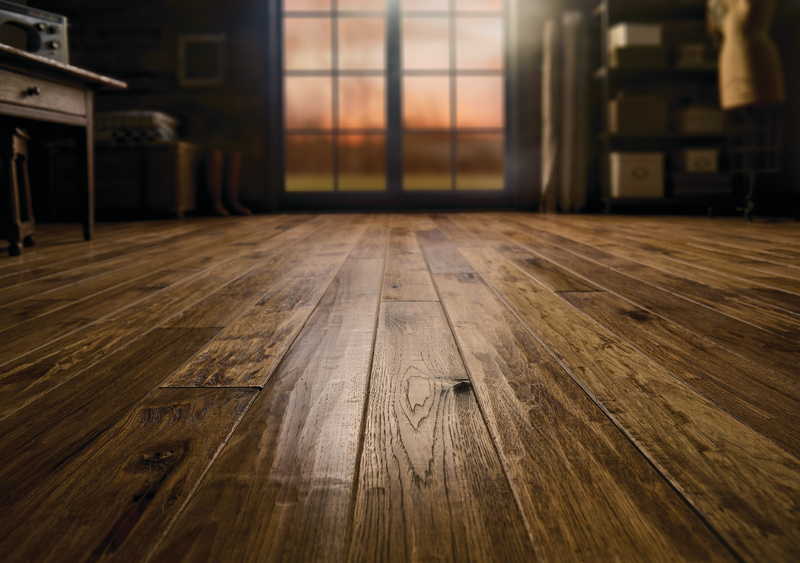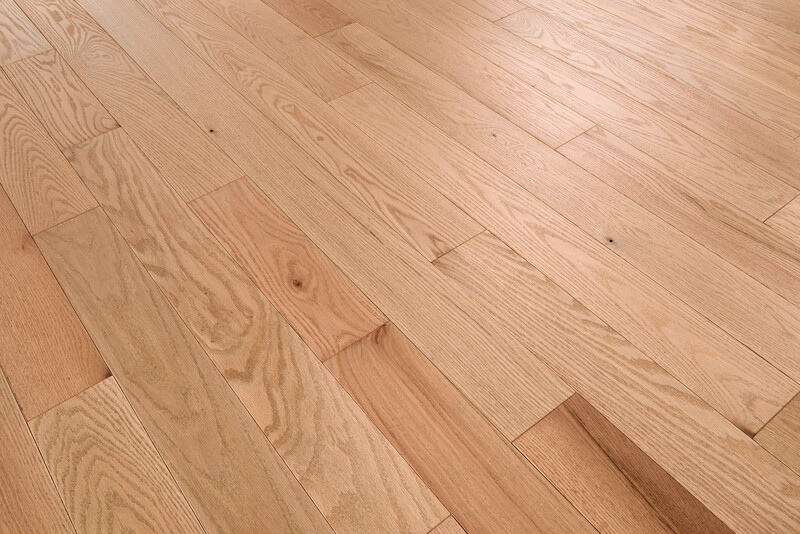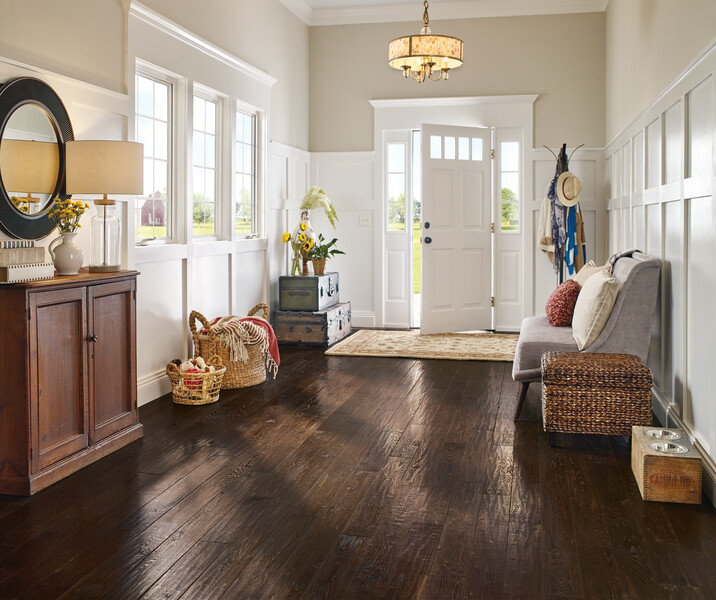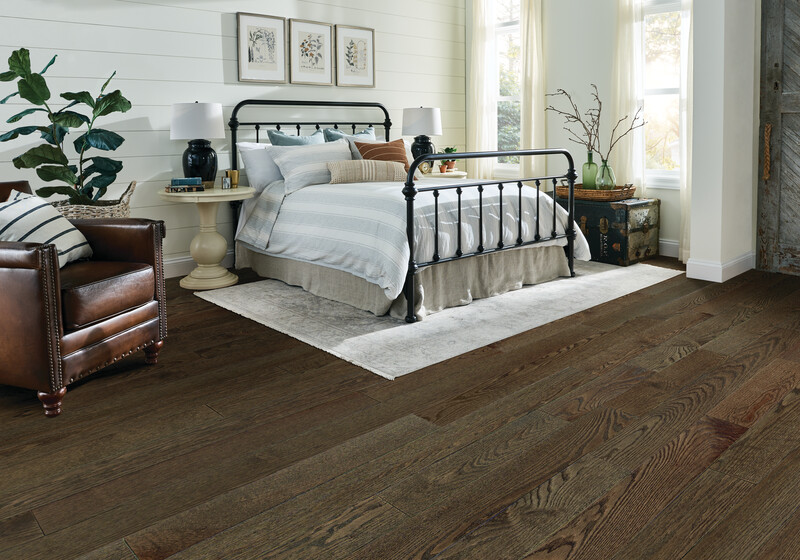Choosing Hardwood Flooring for Different Rooms
Selecting solid hardwood flooring for your home can be daunting. Whether building a new house or replacing old floors, you must pick an appropriate type of wood for each room.
Critical considerations include:
- Selecting an appropriate species based on the room’s activity
- Understanding where engineered hardwood flooring may be a more suitable selection
- Determining the impact of hardwood colors on each room
- Choosing the best plank width to complement a room
We’ll also give you our top choices for the best type of flooring in each room.

Benefits of Natural Hardwood
Choosing natural wood flooring for your home is a decision that brings numerous benefits, combining practicality with timeless elegance. Here’s why it’s such an excellent choice for homeowners (kudos on selecting it):
- Durability and Longevity: Hardwood floors are incredibly durable. With proper care, they can last for decades and, in many cases, a lifetime. This longevity makes them a cost-effective option in the long run.You can sand and refinish the flooring to restore its original beauty. You’ll likely need to replace other flooring options.
- Aesthetic Appeal: Hardwood flooring adds a touch of elegance and warmth to any room. The natural beauty of wood, with its unique grains and textures, can enhance the look of your home.Hardwood floors come in various species, colors, and finishes. So you can choose the perfect look to complement your room’s interior decor. Whether you prefer a modern, rustic, or traditional style, there’s an option for you.
- Increased Home Value: Installing wood flooring can significantly increase the value of your home. Potential buyers often view hardwood floors as desirable, making your home more appealing and increasing its resale value. Hardwood flooring is a classic choice that never goes out of style, ensuring your home remains attractive to buyers over time.
- Ease of Maintenance: Hardwood floors are relatively easy to clean and maintain. Regular sweeping or vacuuming and occasional mopping are usually enough to keep them looking their best. Hardwood doesn’t trap dust, allergens, or pet dander like carpets, making it a healthier flooring option, especially for people with allergies.
- Sustainability: Many hardwood flooring options are environmentally friendly. Wood is a renewable resource, and sustainable forestry practices ensure the maintenance of hardwood production without depleting forests.
Types of Domestic Hardwood Species
The wood species you select for a room impacts your floors’ durability, appearance, and overall feel. Each offers unique characteristics, including varying levels of hardness, distinct grain patterns, and a range of natural colors. Understanding these differences can help you make an informed decision that aligns with your lifestyle and aesthetic preferences.
Oak
Oak is the most popular hardwood choice. Oak flooring is solid and durable, with a noticeable grain pattern.
It comes in two varieties: red oak and white oak. Red oak has a warm, reddish tone, while white oak has a more neutral, grayish hue.
Maple
Maple flooring has a smooth, even grain and a light color. It’s harder than oak flooring, making it more resistant to dents. Homeowners often turn to maple flooring for modern and contemporary decor.
Cherry
Cherry wood has a rich, reddish-brown color that darkens over time. However, it is softer, making it more prone to dents and scratches.
Walnut
Walnut offers a rich, dark color and a beautiful grain pattern. It adds a touch of luxury to a room. Like cherry, walnut is softer than oak or maple and can dent more easily.
Hickory
Hickory is one of the hardest domestic woods, making it a perfect fit for high-traffic rooms. It has a unique, rustic look with a varied grain and a mix of light and dark colors. Hickory flooring readily brings added personality to a room.
Selecting an Appropriate Plank Width
The width of the planks you choose can significantly impact the look and feel of a room.
Narrow Plank Hardwood Flooring
Narrow planks, typically 2 to 3 inches wide, create a more traditional and classic look. By adding visual length, they can make smaller rooms feel larger. So, thin plank flooring is best if you have a small room and want to add a sense of space.

Wide Plank Hardwood Flooring
Wider planks, ranging from 4 to 7 inches or more, offer a more rustic and spacious appearance. However, wide plank floors have also become a favorite in modern homes. They’re ideal for larger rooms and open floor plans, as they can make the space feel more cohesive and expansive.
Mixed Width Planks
Mixed-width planks add a unique, rustic charm to any space, creating a visually appealing and dynamic floor. Different widths give you a more natural and varied look reminiscent of traditional hand-hewn floors. This style can bring warmth and character to a room, blending old-world craftsmanship with contemporary design.
Setting a Room’s Tone with Your Hardwood Color
The color of your hardwood flooring can set the tone for the entire room. Here are some tips for selecting the right color:
Light Colors
Light-colored hardwood floors, such as natural oak or maple, can make a room feel larger and more open. They are perfect for small spaces or rooms with limited natural light.
Medium Colors
Medium-toned floors, like honey or chestnut, offer a balanced look that works well in most rooms. They can add warmth and depth without overwhelming the space.

Dark Colors
Dark hardwood floors like walnut or dark-stained oak create a sophisticated and elegant look. They are best suited for larger rooms with plenty of natural light to avoid making the space feel too dark or cramped.
Wood Finishes Impact Room Selection
The finish you choose for your hardwood flooring will affect its appearance, durability, and maintenance requirements.
Matte Finish
A matte finish offers a natural, understated look that masks scratches and dents. This finish is excellent for high-traffic areas and homes with pets or children.
Satin Finish
Satin finishes provide a slight sheen that adds a touch of elegance without being overly glossy. They are versatile and work well in most rooms.
Glossy Finish
Glossy finishes create a high-shine, luxurious appearance. However, they tend to show scratches, dents, and dust more quickly, making them better suited for low-traffic areas.
A Room-by-Room Guide to Hardwood Flooring
Each room in your home has unique requirements for hardwood flooring. Here are some recommendations for various rooms:
Living Room
The living room is often the home’s focal point, so you’ll want a hardwood floor that is both stylish and durable. Oak withstands more use, while walnut adds a touch of luxury to a pace. Select a medium to dark color with a satin or semi-gloss finish. Consider wide planks for a modern look or narrow planks for a traditional feel.
Dining Room
The dining room sees a mix of traffic and the potential for spills. Oak or walnut with a satin finish can provide a stylish and practical solution. Medium to dark colors work well in this space, adding a touch of elegance.
Kitchen
The kitchen is a high-traffic area prone to spills and moisture. Engineered wood flooring is a better choice here than solid hardwood flooring, with its added moisture resistance. Choose a durable wood type like hickory or oak with a matte finish to hide scratches and dents.
Wide planks are a good selection for kitchens to make them feel more airy.

Bedroom
Comfort and warmth are key in bedrooms. Cherry’s warm, reddish tones create a cozy atmosphere, perfect for bedrooms. With its light color and durability, Maple is an excellent choice for a serene and sturdy bedroom floor.
A matte or satin finish helps promote a cozy atmosphere. Light to medium colors are ideal for making the space feel inviting.
Bathroom
Most homeowners avoid solid wood flooring in bathrooms because of their moisture concerns. Engineered hardwood with a water-resistant finish can be an option. Opt for a durable wood like oak, and ensure proper sealing and maintenance.
Another option is waterproof hardwood flooring.
Basement
Another perfect room for engineered hardwood. Basements often have higher humidity and temperature fluctuations, which engineered hardwood can withstand better than solid hardwood.
Basements can be dark, so choose a lighter-colored floor to add light to the room. A matte or satin finish will help hide scratches and dirt, primarily if you use your basement a great deal.
Hartco® Has Hardwoods for Every Room
Choosing the right hardwood flooring for each room in your home involves considering various factors, including wood type, plank width, color, and finish. By understanding these elements and selecting the appropriate options for each space, you can create a cohesive and beautiful home that reflects your style and meets your functional needs.
Investing in quality hardwood flooring and proper maintenance will ensure your floors look stunning for years. So, take your time, explore your options, and make informed decisions to create the perfect foundation for your home.
Hartco® can help with more than 300 hardwood and engineered hardwood flooring selections. You can choose different looks, including traditional, hand-scraped, distressed, and wire-brushed. We also offer extra wide planks up to nine inches for added character.
Find quality, real hardwood flooring near you using our store locator.
